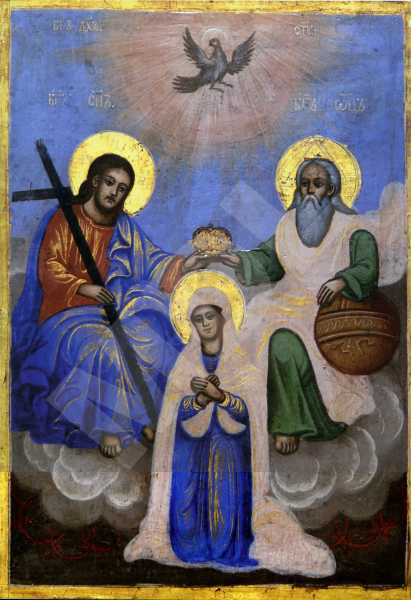The New Testament Trinity
Type:
Icon
Period:
1867 year
TSONYU SIMEONOV (1823 - 1885) is among the most talented icon painters in the celebrated Vitanov family. He became the bearer of the best in the traditions of the school to that day. Except for an aspiration after beautiful and harmonious images and a mastery of the icon painting technique, his works reveal a maximum of realism and a unique sense of colour. Striking is the realism of his landscapes. Tsonyu Simeonov painted with ardour each de ail in the icon, be it in the decoration of the clothing, an element of nature or architecture. He mastered the proportions of the body to ·perfection and employed purely artistic devices to command the space in the icon. In many of his works he succeeded in creating an illusion· of three dimensionality, depth and inner light. However, not all his efforts turned out well. Aiming to convey more solemnity and realism, he frequently went as far as an excess of details and utter discrepancy with the very essence of the icon, its conventionality. A host of clouds and nimbuses appeared around the images of the saints which testifies to the painful decline of the traditional icon painting in Tryavna.
Tsonyu Simeonov began his active artistic career in the mid of the 19th century. Over this period the Trayvna art school produced its best achievements, exhausted ·its potential and witnessed the beginning of its decline. Everything painted in the second half of the century was either a mechanical repetition of old examples or vague reminiscences of the best created by the former generations. Therefore, the efforts of an indisputably talented painter like Tsonyu Simeonov to renovate the icon and continue its development were a success only in so far as his icons turned into festive pictures on religious subject-matter to a great extent. Works by Tsonyu Simeonov can be found in Elena district, Lyaskovets, Svishtov, in the monasteries around Veliko Tarnovo, etc.
Tsonyu Simeonov was a very good woodcarver as well. As maintained by Dabko Usta Genchov, he was the master carver of a splendid walnut frame which enclosed an address of thanks by the Bulgarian people to Prince Dondukov-Korsakov. He also carved Prince Batenberg's throne for his coronation in the old capital (1879). Tsonyu Simonov's art hovered near the border of secular art but the artist never crossed it.
Location
Country: Bulgaria
Province: Gabrovo
Town: Tryavna
Description
A traditional compositional treatment of the theme.
Iconographical technique: Tempera
Base material: Wood
Beech board


